
Content
Welcome to the Club of Amsterdam Journal.
Once upon a time there was money. It has lubricated our civilisations from the earliest days. But how many people really understand it? And if people don’t understand money, how can they understand the implications of banks being increasingly in control of, and knowledgeable about, our transactions? Then along come cryptocurrencies, which can take banks out of the equation. A fascinating evolution, or is it a battle? – Paul Holister
The Future Now Show: Cryptocurrencies with Hardy F Schloer
“ULTRANOW briefings by Lise Voldeng are advisory bullets traversing every sector of civilization – providing forecasting, analysis and advisory insights on how to prosper integrously.
Felix F Bopp, Founder & Chairman
The EU Global Strategy – Year 1
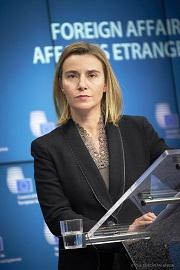
Personal Message by Federica Mogherin
High Representative of the Union for foreign and security policy / Vice-President of the European Commission
“A fragile world calls for a more confident and responsible European Union, it calls for an outward and forward looking European foreign and security policy. Our citizens understand that we need to collectively take responsibility for our role in the world. This is no time for uncertainty: our Union needs a strategy. We need a shared vision, and common action.”
We have lived through an eventful year in Europe and beyond. If I think back to June 2016, when I presented the Global Strategy for the European Union’s Foreign and Security Policy, the world was a very different place. Since then, the Global Strategy has helped us steer the course of our foreign and security policy through difficult times.
First of all, the Global Strategy has served as a springboard to relaunch the process of European integration after the British referendum. One year ago, after that referendum, many predicted an “inevitable” decline of the European Union, and imagined that the Global Strategy would stay in a drawer or would very soon look outdated. Others told us that the change the Global Strategy advocated for would have taken years to turn into reality, or might simply never happen. This has not been the case. On the contrary, we have moved fast – and united – on concrete implementation, starting with security and defence. In this field, more has been achieved in the last ten months than in the last ten years. The new command centre for EU military training and advisory missions is now reality. A coordinated annual review of national defence budgets is taking shape. Preparations for a Permanent Structured Cooperation on defence among interested Member States are moving forward.
Far from being outdated, the Global Strategy has stood to the test of time in a very dense year. The Global Strategy’s push for a European Union of security and defence, in complementarity with NATO and all our partners, anticipated the debate on military burden-sharing across the Atlantic. In a moment when the crucial role of the United Nations’ system, the importance of development cooperation, or the reality of climate change are put into question, the Global Strategy has been a reminder of the European Union’s strategic interest in a cooperative world order. It has helped us swim against the tide, keeping our unity and building strong global alliances around our key priorities.

A Global Strategy for the European Union
In a complex, connected, and contested world, it is essential for the EU to ensure peace and security for its citizens and territory, as well as advance the prosperity of its people. On top of this, the EU needs to uphold the strength and values of democracy and champion a rules-based global order
Introduction
We have lived through an eventful year within and beyond our European Union. Internally, we faced the United Kingdom’s referendum, a succession of key elections in several European countries, the beginning of a sustained economic recovery, and the 60th anniversary of the Rome Treaties, which both celebrated our past and projected our hopes into the future. The new US Administration is reshaping America’s role in the international arena. Ongoing conflicts and tensions near and far, and the persisting threat of terrorism across all continents, including in the heart of Europe, continue to affect the daily life of ordinary citizens.All these trends and events have made the EU Global Strategy for the European Union’s foreign and security policy (EUGS), presented by High Representative and Vice President of the European Commission (HRVP) Federica Mogherini to the European Council in June 2016, a timely tool to tackle complexity within and beyond the EU’s borders. As the title of the EUGS itself suggests – Shared Vision, Common Action: A Stronger Europe – the work was not meant to stop with the elaboration of a shared vision, but to trigger a new beginning through common action. This is why EU Heads of State and Government welcomed the presentation of the Strategy and invited the High Representative, the Commission and the Council to take the work forward.
Resilience of states and societies to our East and South
Almost one fourth of the world’s population lives in fragile states or societies. (2) This year we have focused on preventing many of these fragile situations from turning into new wars, new humanitarian disasters, new refugee crises: we have worked to strengthen the resilience of states and societies to our East and South. We have engaged with governments and institutions as well as with civil society organisations and private actors. Our actions have spanned from security sector reform in Ukraine to the training of the Libyan coastguard, from supporting Syrian refugees and their host communities to setting up a European External Investment Plan for private companies to safely invest in fragile parts of our surroundings.Resilience is not a new concept. It is a notion that has been used for several years now amongst the humanitarian and development communities – starting with the 2012 Commission Communication on Resilience, the subsequent Council Conclusions and the Resilience Action Plan 2013-2020 – and more recently by the energy and climate as well as by the security and defence communities. To fully translate this common concept into common action, in June 2017 the Commission and the High Representative released a Joint Communication on Resilience. The Joint Communication builds on the ongoing experience in the humanitarian-development context and provides a shared policy framework within which different strands of work in the EU can become more effectively coordinated amongst themselves, and together with external partners.A particular focus is placed on resilience in the EU’s Eastern and Southern neighbouring countries. This reflects the special political commitments of the accession process and the EU’s Neighbourhood Policy. The 2015 Review of the European Neighbourhood Policy was closely coordinated with work on the Global Strategy, and implementing the Review is a major part of our work on strengthening resilience in the region. A joint report on the implementation of the European Neighbourhood Policy Review was published on 18 May 2017
An Integrated Approach to Conflicts and Crises
Our external action is increasingly attentive to conflict prevention and post-conflict peacebuilding, beyond mere crisis management. At the Brussels international conference on the future of Syria and the region, co-hosted by the EU in April 2017, the international community started to reflect also on the reconstruction of the country, which will have to begin when a political transition is firmly under way. Both regional actors and, crucially, representatives of Syrian civil society have welcomed this approach and praised its positive impact in support of peace.In Colombia, we made sure that the moment a peace deal was signed, we could step in with financial support for reconciliation. In Afghanistan, we have coupled our work for stabilisation inside the country with a renewed diplomatic push with regional powers in support of peace.
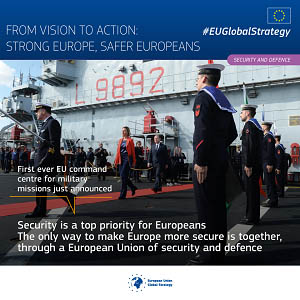
Security and Defence
Security and DefenceIn the area of security and defence, more has been achieved in the last ten months than in the last decade. Issues that only one year ago seemed out of reach – from a permanent planning and conduct capability for non-executive EU military missions to the activation of a Permanent Structured Cooperation between willing and able Member States – are fast becoming realities. The foundations of a European security and defence union are rapidly and solidly being built.The EUGS called for “a sectoral strategy, to be agreed by the Council” specifying “the civil-military level of ambition, tasks, requirements and capability priorities stemming from this Strategy.” The Implementation Plan on Security and Defence presented by the HRVP in November 2016 went far beyond this.Drawing on the Implementation Plan on Security and Defence, the Foreign Affairs Council Conclusions in November 2016 agreed on a new level of ambition in security and defence, based on three strategic priorities derived from the EUGS: responding to external conflicts and crises, building capacities of partner countries, and protecting the EU and its citizens. Stemming from this, the Council outlined thirteen taskings aimed at equipping the EU to realise its declared level of ambition. In December 2016 this level of ambition and work plan were endorsed by the European Council, as part of a broader defence package which included as well the European Commission’s European Defence Action Plan, aimed at facilitating and incentivising defence cooperation between Member States through the establishment of a research and of a capability window, and the implementation of the Warsaw Joint Declaration of EU and NATO leaders.
Changing the way we work: a joined-up Union
The implementation of the EUGS has not only meant the activation of individual work strands on the strategic goals selected by the Strategy. It has also triggered the transformation of a method of work: of the way in which the EU does foreign policy. A leitmotif in the EUGS is the notion of a joined-up Union: the idea that the full potential for EU foreign policy can only be realised if the Union works jointly across policy sectors, institutions and Member States. In implementing the EUGS in all the work strands discussed above, such a joined-up approach was followed through. The work on security and defence for example has brought together the Council and Member States, the European Defence Agency and the Commission; it has been discussed with the European Parliament and debated thoroughly by the expert community across most Member States.The same approach applies to a number of initiatives, from regional strategies to thematic ones; from climate, energy, oceans governance and economic diplomacies, to culture in international relations, youth initiatives or the European Instrument for Democracy and Human Rights (link is external).In order to deepen further this joined-up approach, the October 2016 Foreign Affairs Council selected two priorities for the first year of implementation which are horizontal by their very nature: the internal-external nexus and public diplomacy.
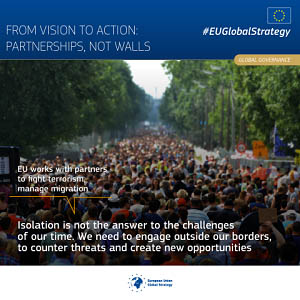
The internal-external nexus
The internal-external nexusWorking on the internal-external nexus means that internal and external initiatives within the same policy domain must be coherent and mutually reinforcing.Given the importance that the EUGS attaches to the United Nations’ 2030 Agenda, achieving the Sustainable Development Goals (link is external) is an integral part of implementing the Global Strategy. The new European Consensus on Development promotes a coherent approach to people, planet, prosperity, peace and sustainability that is fully consistent with the EUGS, including its emphasis on building resilience at all levels. The Consensus was agreed by the European Commission, the European Parliament, the Council, as well as by the representatives of Member State governments meeting with the Council: for the first time ever, the Consensus applies in its entirety to EU institutions and to all EU Member States. Ensuring consistency between internal and external action is central to the implementation of the SDGs. For this reason, coordinated initiatives have been taken not only on the external implementation of the 2030 Agenda, but also to ensure consistent implementation through EU internal policies. This has been recently highlighted in the Council conclusions on “A sustainable European future: the EU response to the 2030 Agenda for Sustainable Development”
Public diplomacy
The elaboration of the EUGS involved an unprecedented public consultation, both within and outside the European Union. The HRVP herself has visited extensively Africa, Asia and Latin America to promote the cooperation envisaged by the Global Strategy.We finally realise that it is essential not only to communicate the added-value of the EU’s action, but also to open new channels for European and non-European citizens to engage with EU policy-making. Too many young people feel excluded from political processes, and struggle to find a place inside our societies. During this year, we have worked to invest in existing dialogue initiatives, but also to create new opportunities for young people to have a say and new channels of participation: this is the aim of the new Young Med Voices Plus initiative, launched by the HRVP, which has already brought a group of young people from Europe and the Mediterranean to discuss policy proposals and present them to representatives of the EU institutions. This kind of initiative can also help build a network of EU-minded opinion makers in our region.
The Work Ahead
It was an intense first year in the implementation of the EU Global Strategy. This work does not and cannot stop here. In the year ahead, the EU will continue to pursue the work strands which have been opened so far, notably but not exclusively in the key field of security and defence. And it will continue to work in a joined-up manner, internally across institutions and Member States, along the internal-external policy nexus, or externally through its work on public diplomacy.The Council and the Commission may also consider exploring other fields for the implementation of the EUGS, possibly focusing on strategic goals such as the support for cooperative regional orders and global governance, as well as means such as the establishment or empowerment of more responsive and flexible tools in the fields of diplomacy and development, as advocated by the Strategy.The journey translating the EU Global Strategy from a shared vision into common action has begun. Let us keep up this momentum in the year ahead of us.
Key Documents
A Global Strategy for the European Union
After the EU Global Strategy – Building resilience
The CARD on the EU defence table
What humans will look like in 1,000 years
The Future Now Show
Every month we roam through current events, discoveries, and challenges – sparking discussion about the connection between today and the futures we’re making – and what we need, from strategy to vision – to make the best ones.
Shape the future now, where near-future impact counts and visions and strategies for preferred futures start.
Do we rise above global challenges? Or do we succumb to them? The Future Now Show explores how we can shape our future now – where near-future impact counts. We showcase strategies and solutions that create futures that work.
Every month we roam through current events, discoveries, and challenges – sparking discussion about the connection between today and the futures we’re making – and what we need, from strategy to vision – to make the best ones.
The Future Now Show
September 2017
Cryptocurrencies
with
Hardy F Schloer
Artificial Intelligences (AIs) are being increasingly used in real applications. An example, discussed here, is using them to mimic the goings-on in a simulation of a real city (or even country), from traffic flow to electricity and water consumption. This allows us to play with possible variations (which energy sources to use, extreme scenarios etc.) and make wiser decisions about the real city. But hang on; if the AIs can figure this out, why not let them manage the city for us? — Paul Holister
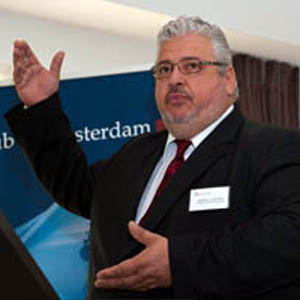
The Pregnancy Panopticon

by Cooper Quintin, Staff Technologist, Electronic Frontier Foundation
Women’s health is big business. There are a staggering number of applications for Android and iOS which claim to help people keep track of their monthly cycle, know when they may be fertile, or track the status of their pregnancy. These apps entice the user to input the most intimate details of their lives, such as their mood, sexual activity, physical activity, physical symptoms, height, weight, and more. But how private are these apps, and how secure are they in fact? After all, if an app has such intimate details about our private lives, it would make sense to ensure that it is not sharing those details with anyone, such as another company or an abusive family member. To this end, EFF and Gizmodo reporter Kashmir Hill have taken a look at some of the privacy and security properties of nearly twenty different fertility and pregnancy tracking applications. While this is not a comprehensive investigation of these applications by any means, we did uncover several privacy issues, some notable security flaws, and a few interesting security features in the applications we examined. We conclude that while these applications may be fun to use, and in some cases useful to the people who need them, women should carefully consider the privacy and security tradeoffs before deciding to use any of these applications.
Read the report: “The Pregnancy Panopticon”.
This document is a technical supplement to “What Happens When You Tell the Internet You’re Pregnant” published by Kashmir Hill on jezebel.com
News about the Future
Future of an Ageing Population
People in the UK are living longer than ever before – a major achievement of modern science and healthcare. Older people make up a growing proportion of the population, and so make an increasing contribution to society. They are our workers, volunteers, taxpayers and carers.
However, the UK is not making the most of the opportunities afforded by an ageing population. Too many people are forced out of work in later life by poor health or unwelcoming attitudes in the workplace. Too few people access the training they need to adapt to a changing labour market. Too many families face the choice between working and providing care for a loved one. Too few homes meet the needs of older people.
The ageing of the population also challenges the UK’s model of service provision. If an older population means fewer workers at the same time as greater demand for public services, this raises questions about the sustainability of the current models of working lives and care provision.
The UK has a choice. Will the growing number of people in later life be predominantly empowered, skilled, healthy and able to contribute fully to society? Or will we be increasingly unhealthy, disempowered and dependent? Answering this challenge cannot be Government’s job alone. Employers will need to adapt to an ageing workforce. Families and communities have a role to play in supporting their loved ones to age well. Individuals can, and must be supported to, make choices which will better prepare them for a happy, productive and fulfilling later life – The Rt Hon Oliver Letwin MP

Future scenarios for research & innovation policies in Europe – Study
The growing complexity of the world will require that society develop more options for coping. Options will come from new discoveries, inventions, ideas – in short, from research and innovation. This foresight report, commissioned by the European Commission’s Directorate-General for Research and Innovation, draws on a broad range of sources about megatrends shaping the world today and projects them forward into the 2030s. The report describes two possible outcomes: That the trends go on unmanaged and uncontrolled, or that society takes action. The first outcome would be negative: climate…
How Will Nanotechnology Change the World
by National Geographic
Recommended Book


Life 3.0: Being Human in the Age of Artificial Intelligence
by Max Tegmark Knopf
How will Artificial Intelligence affect crime, war, justice, jobs, society and our very sense of being human? The rise of AI has the potential to transform our future more than any other technology — and there’s nobody better qualified or situated to explore that future than Max Tegmark, an MIT professor who’s helped mainstream research on how to keep AI beneficial.
Trump’s Afghan Military Solution Will Fail

James Dorsey tells Paul Jay, The Real News Network, that Trump’s plan is to force the Taliban to negotiate, but there is no reason for them to do so.
See also
The Future Now Show
James Dorsey – 2016 & 2017: Quest for Change
ULTRANOW BRIEFINGS: TRUE POWER
ULTRANOW briefings are advisory bullets traversing every sector of civilization – providing forecasting, analysis and advisory insights on how to prosper integrously.
ULTRANOW briefings are brought to you by Ultra-Agent Industries Inc. and UAI CEO Lise Voldeng. UAI is an accelerator. We train individuals to lead themselves, their lives, their organizations, and their countries with joyous, prosperous integrity. We forecast developments across every sector of civilization. We develop product solutions for every sector of civilization. And we invest in, advise, and mentor individuals and organizations.
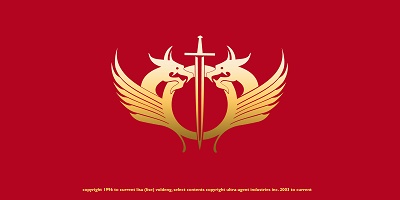
www.ultraagentindustries.com
ULTRA-AGENT INDUSTRIES INC.
[ worldbuilder luxe. for warrior worldbuilders. ]
shows:
ULTRANOW LETTER BRIEFING:
TRUE POWER
Insight courtesy of UAI CEO Lise Voldeng. Title credits music courtesy of UAI CEO Lise Voldeng and Elad Marish. Supported by the Club of Amsterdam.
Lisa (Lise) Voldeng: CEO, creator, futurist, and investor. Runs accelerator Ultra-Agent Industries Inc. Loves icecream and integrity.

Voldeng consistently forecasts global developments (across every sector of civilization) and successfully implements solutions to help us prosper. She builds brands, markets, organizations, platforms, products, and experiences. She invests in, advises and mentors individuals and organizations who want to prosper integrously.
Futurist Portrait: Glen Hiemstra
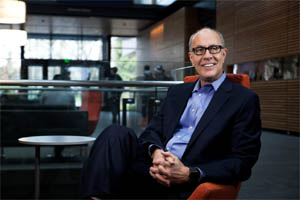
Glen Hiemstra is the founder and owner of Futurist.com. Glen is dedicated to disseminating information about the future to assist individuals, organizations, and industries in effective strategic planning. An internationally respected expert on future trends, long-range planning and creating the preferred future, Glen has advised professional, business, and governmental organizations for two decades and has served as a technical advisor for futuristic television programs. Audience members for Glen’s keynote speeches and clients for his long-range planning say things like, “Once you hear Glen Hiemstra speak, the future will never look the same.”
A writer as well as a speaker and consultant, Glen is the author of Millennial City: How a New Generation Can Save the Future,Turning the Future into Revenue: What Businesses and Individuals Need to Know to Shape Their Future (Wiley & Sons 2006). Previously he co-authored Strategic Leadership: Achieving Your Preferred Future.
If you listen carefully, you can learn what the future is telling you
Glen has worked with many leading companies, government agencies and organizations across a wide variety of domains. These include Microsoft, The Home Depot, Boeing, Adobe, Ernst & Young, PaineWebber, ShareBuilder, Ambrosetti (Italy), Club of Amsterdam, U.S. Army Corps of Engineers – Savannah District, U.S. Army Corps of Engineers – Pacific Ocean Division, Northern Telecom, REI, Weyerhaeuser, Hewlett Packard, Novo Nordisk, U.S./Mexico JWC, APAX Partners, Costa Rica Hotel Association, Atlanta 2060, Tulsa 2025, Idaho Transportation 2030, Michigan DOT 2030, Federal Highway Administration Advanced Research, Eddie Bauer, Procter & Gamble, ACE Hardware, IHOP, John Deere, Weitz Construction, Lexis Nexus, Land O Lakes, GHD Engineering (Australia), SONAE (Portugal), and others.
Glen Hiemstra Keynotes Lundbeck Global Conference





Customer Reviews
Thanks for submitting your comment!